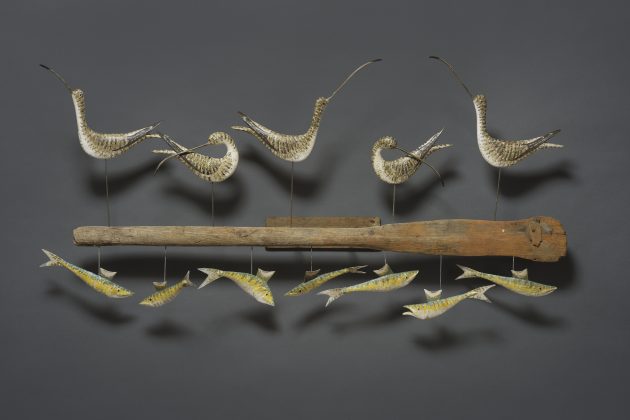Stephen Henderson’s evocative sculptures of birds capture the art and marshland in his DNA, as he explains to Janet Menzies
Inspired by wooden decoys and wildlife as a child, Stephen Henderson tells Janet Menzies about his unique passion and style for creating sculptures of flocks of curlew and grebes.
Find out about how Virginia Woolf, Henderson’s great-aunt, and his father’s, Nigel Henderson, style and format creep in to his work.
STEPHEN HENDERSON
Stephen Henderson’s studio looks out over the Essex marshes near Hamford Water. He describes the scene: “Winter is here and there are big flocks of teal and wigeon and I can see golden plover and curlew. When there is snow the mudflats are covered and it is completely white, and the dawn comes up and the light is wonderful.” His sculptures of the scene feature just the birds and perhaps a suggestion of driftwood or shoreline in the mount, yet he evokes the whole landscape and, more than that, the history and meaning of that environment.
Perhaps this is because Henderson was born and brought up here, in a former bargers’ and even smugglers’ pub, The King’s Head, so maybe the landscape is in his DNA. He explains: “This house was originally bought by my grandparents, Adrian and Karin Stephen, in the 1930s, and was then passed on to my parents, Nigel and Judith Henderson, who came to live here in the early 1950s just before I was born. I grew up running around in the mud and finding things. With the house having been a pub there were all sorts of left-overs, old ginger bottles and things from the barge days.
“I loved the wildlife from the beginning and learnt a lot from Oliver Dansie the ornithologist, who was the father of a friend. Even as a child I liked getting into my father’s workshop while he was making assemblages of found objects or collages, and he encouraged me when I began sculpting in wood.”

Great Crested Grebes with chicks
His father was Nigel Henderson, the much-admired mixed-media artist who is exhibited at Tate Britain, so it was instinctive for him to create. Step back a generation further, and you find the Bloomsbury group and Henderson’s great-aunt, Virginia Woolf, one of the greatest exponents of the things unsaid. So, when Henderson sculpts Five Curlew Silhouettes on Driftwood or Three Sandpipers, there is, of course, precise and evocative execution but also an implicit reference to the marshes and a narrative response to this lonely, low-horizoned landscape. It is easy to imagine Dickens looking out over the mudflats, or Woolf remembering something similar on the shores of Skye when writing To The Lighthouse.
Henderson comments: “I think it is about an instinctive reaction – you can catch a connection between the maker and the subject. There is a narrative in my pieces where sometimes the space within the sculpture is something more than the piece itself. You can try three or four or more ways of putting the sculpture together and then suddenly something happens that feels unexpected but wonderful. As an artist you are waiting for that to come through, but you can’t plan for it. I think watching my father work in collage helped me to recognise that.”
But Henderson’s work is all his own, although he recognises the role of Guy Taplin, the renowned creator of evolved decoy. “I had been given some old wooden decoys as a child. They were very worn down but the line was beautiful and I knew I wanted to copy that. Then I met Guy Taplin in the 1990s. We went for walks together and that really inspired me that this work could be a way of life. Guy passed on to me a lot of very early American decoy ducks and books of descriptions. Then I began to experiment more, trying to achieve freedom of line that isn’t always there with a purpose-made decoy. Guy helped me to see there was a way between naturalistic carving and expression.”

Black Throated Diver
Finding that way was Henderson’s next challenge. “Developing my own techniques was important,” he explains. “For example, I like to work in white pine, but the grain tends to stand up, which spoils the carving, so I have developed a way of burning off the outside, which gives a lovely softness to the finish. Then when it comes to the mounts, I like to use found objects and driftwood.”
Mud larking and beach-combing the estuary has given Henderson a deep connection with the sometimes unloved expanse of the Essex wetlands, and he talks about its backwaters as a true home. “We get flatfish here in the backwaters and I feel an affinity with the flatfish, lying there on the bottom, in among the grasses and roots and the mud. I love to see them quietly living in their environment.”
His sculpture, Above and Below, features a line of wading birds, long-beaked for probing the mudflats and, beneath them, the fish that lie below the water – unseen except through Henderson’s particular perspective.
View Stephen Henderson’s work at: birdsandfish.co.uk. To visit his studio at The Kings Head, Landermere Quay, Essex, call 07747621110.
He exhibits regularly at the Rountree Tryon Gallery, Petworth, West Sussex, and at the Pinkfoot Gallery, Cley-next-the-Sea, Norfolk.





